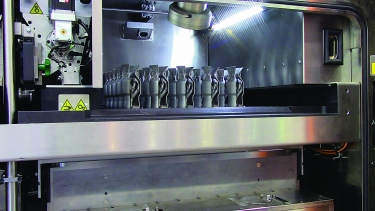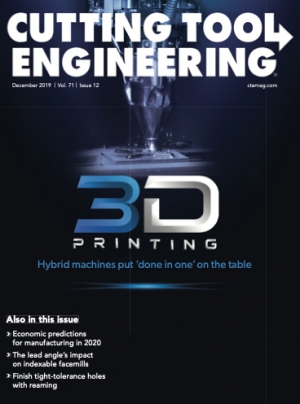As additive manufacturing and 3D printing of metal and composite parts continue to make inroads into production environments, the need to efficiently and effectively finish-machine parts when that step typically is required gains importance.
One way to do it is with a hybrid machine tool, which performs both additive and subtractive operations. A feature article about these machines by contributing writer Kip Hanson appears on Page 24, and the Look-Ahead column by freelance writer Ken Schnepf covers the MasterPrint 3D printer from Rockford, Illinois-based Ingersoll Machine Tools Inc. The machine 3D-prints and mills extra-large, single-piece composite and metal parts. (See Page 56.)

GF Machining Solutions displays the Cut AM 500 horizontal wire EDM at EMO. Image courtesy of A. Richter
Other times, printed parts that require machining are moved to another machine for material removal after the build process. Nonetheless, they first must be cut from the build base, such as with a conventional wire EDM or a bandsaw. An alternative method is from GF Machining Solutions LLC, Lincolnshire, Illinois. The machine tool builder offers the new AgieCharmilles Cut AM 500 horizontal wire EDM for cutting off additively manufactured parts from build bases. The EDM cuts parts without pressure, damage or material alteration, and there is minimal material waste, according to the company. See contributing writer William Leventon’s Machine Technology column on Page 16 to learn more.
I had the opportunity to see the Cut AM 500 during a GFMS-sponsored trip to company facilities in Switzerland, which included a tour of its EDM factory in Losone. My fellow travelers included GFMS customers and some of their spouses, as well as a few other members of the trade press. While at the EMO Hannover trade show in Germany, I saw the EDM demonstrated. It was the first time I attended the massive metalworking event.
Another highlight of the trip was the tour and inauguration of the company’s new innovation and production center in Biel. After a two-year construction period, the factory for building milling machines was completed in May at a cost of about $100 million. The center has an area of about 44,000 sq. m (473,612 sq. ft.).
“From this new location, we will be able to strengthen our position as a global player and at the same time rely on our Swiss roots,” said Pascal Boillat, president of GF Machining Solutions Management SA, during his speech at the event.
In addition to seeing two milling machines that the company has not officially launched yet, the new Uniqua human-machine interface and a presentation about factory digitization, I learned more about GFMS’ DMP Flex 350 and DMP Factory 500 metal 3D printers. GFMS designs the machines for industrial applications, and 3D Systems Inc., Rock Hill, South Carolina, handles the printing portion. That sounds like a hybrid partnership.
Related Glossary Terms
- bandsaw
bandsaw
Machine that utilizes an endless band, normally with serrated teeth, for cutoff or contour sawing. See saw, sawing machine.
- electrical-discharge machining ( EDM)
electrical-discharge machining ( EDM)
Process that vaporizes conductive materials by controlled application of pulsed electrical current that flows between a workpiece and electrode (tool) in a dielectric fluid. Permits machining shapes to tight accuracies without the internal stresses conventional machining often generates. Useful in diemaking.
- gang cutting ( milling)
gang cutting ( milling)
Machining with several cutters mounted on a single arbor, generally for simultaneous cutting.
- look-ahead
look-ahead
CNC feature that evaluates many data blocks ahead of the cutting tool’s location to adjust the machining parameters to prevent gouges. This occurs when the feed rate is too high to stop the cutting tool within the required distance, resulting in an overshoot of the tool’s projected path. Ideally, look-ahead should be dynamic, varying the distance and number of program blocks based on the part profile and the desired feed rate.
- metalworking
metalworking
Any manufacturing process in which metal is processed or machined such that the workpiece is given a new shape. Broadly defined, the term includes processes such as design and layout, heat-treating, material handling and inspection.
- milling
milling
Machining operation in which metal or other material is removed by applying power to a rotating cutter. In vertical milling, the cutting tool is mounted vertically on the spindle. In horizontal milling, the cutting tool is mounted horizontally, either directly on the spindle or on an arbor. Horizontal milling is further broken down into conventional milling, where the cutter rotates opposite the direction of feed, or “up” into the workpiece; and climb milling, where the cutter rotates in the direction of feed, or “down” into the workpiece. Milling operations include plane or surface milling, endmilling, facemilling, angle milling, form milling and profiling.
- sawing machine ( saw)
sawing machine ( saw)
Machine designed to use a serrated-tooth blade to cut metal or other material. Comes in a wide variety of styles but takes one of four basic forms: hacksaw (a simple, rugged machine that uses a reciprocating motion to part metal or other material); cold or circular saw (powers a circular blade that cuts structural materials); bandsaw (runs an endless band; the two basic types are cutoff and contour band machines, which cut intricate contours and shapes); and abrasive cutoff saw (similar in appearance to the cold saw, but uses an abrasive disc that rotates at high speeds rather than a blade with serrated teeth).
- wire EDM
wire EDM
Process similar to ram electrical-discharge machining except a small-diameter copper or brass wire is used as a traveling electrode. Usually used in conjunction with a CNC and only works when a part is to be cut completely through. A common analogy is wire electrical-discharge machining is like an ultraprecise, electrical, contour-sawing operation.


